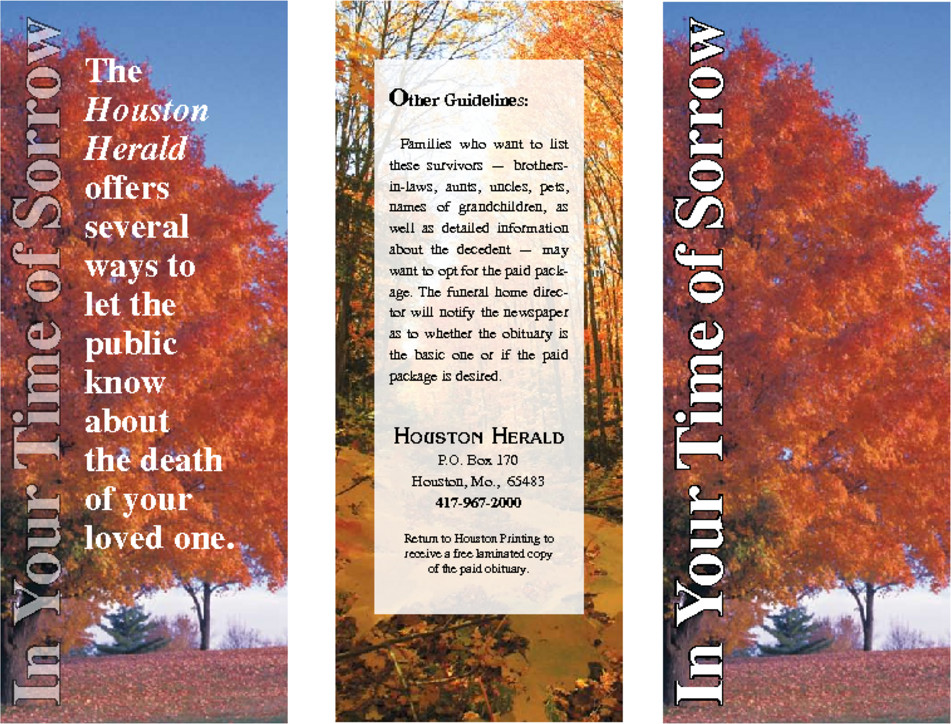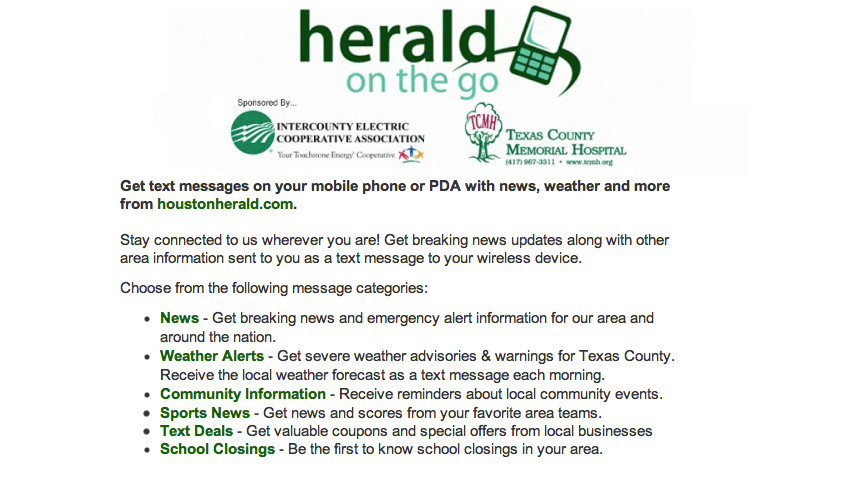Text messaging daily obits increases sales of obituary services
The Houston Herald has built up its obituaries franchise using texts and partnerships with funeral homes
Media: The Houston Herald
Circulation: 10,000
Site: houstonherald.com
Traffic: 102,000 UVs, 528,000 page views
Owner: Brad Gentry
Key Executives: Brad Gentry, Publisher; Jeff McNiell, Editor![]() Initiative: Increase monetization of online death notices and obituaries
Initiative: Increase monetization of online death notices and obituaries
Challenge: Three years ago, the Houston Herald, a weekly newspaper serving Texas County, Mo., ran private party print-only death notices (with time, date, and place of funeral services) and obituary write-ups (person's photo, life story and survivors, as written by the family), for free, and required submissions meet strict space limitations. Death notices were also posted on to their community cable channel 7 for $15. The media-owned channel has a small audience for calendar and news headlines besides obituaries.
As the dominant - though small - media situated in between and on periphery of the two closest TV stations news coverage, the Houston Herald had the obituaries franchise to itself and wanted to do more. Ultimately the team created death notices and obituaries upsells to digital products, and created a partnership with funeral homes, that currently were not advertising.
Strategy: The company decided to create a digital strategy that include an online area for funeral notices and obituaries and text alerts and sell packages via the local funeral homes.
1. Creating an online strategy
While the Houston Herald team looked at a partnership with Legacy, the leading provider of online obituary services for print media, it decided that the services were "too pricey" and to put together a strategy on their own.
Death notices are published as part of braking news, and also on a new online area for funeral services on Houstonherald.com, with links to funeral homes for directions and more information. Obituaries, which can run longer online than in print, are also posted online.
advertisement
2. Creating daily text alerts for death notices
The company chose Textcaster's platform to host opt-in for text alerts for death notices. Texcaster is unique in that it will host the registration page with multiple opt-in's, or provide the API for those media sites that want to build their own (see pages to the right, click to enlarge). The service also allows readers to receive breaking news by text, including death notices, sports, school closings and weather alerts. The service eventually signed 1,500 subscribers for all of the alerts.
3. Packaging the program
Private parties can purchase a print/online/text announcement for $50. It's a simple buy that everyone can understand. Special requests for additional obituary space online is also available.
"This helped us too because every now and then, someone would ask why we didn't include an announcement, and we'd have to say because it did not meet the word count guidelines. Now can say whatever they want to. It seems like it has built good will," Gentry said.
4. Creating partnerships with funeral homes.
The next step was to create a package for funeral homes to partner to upsell the notices. They do not receive a revenue share, since it is perceived as a benefit.
"Funeral homes feel like we are providing a service they've never had," Gentry said.
Funeral home personnel were given administrative access, so they could enter houstonherald.com on their own, provide information for an upcoming funeral service, link to their site and send out a text message.
The package charges funeral homes $250/month, plus $50 paid by the funeral home to post the service, including (photo, longer obituary and online link).
Marketing the program to funeral homes: The paper sent reps to market the program to local funeral homes. There are four funeral homes in the county wide, though the largest one is in Houston, which runs 200 funerals a year. Each home that signed up also received brochures they could hand out to customers, describing the new services they could provide (see attachment)
"The funeral homes were enthusiastic and we didn't have any push back. We should have done it a long time ago."
"The funeral homes are doing the work. All we're doing is placing it on the website. From there the process is pretty seamless."
What's in it for the funeral homes? A huge savings in time from people calling to find funeral service information, who now receive text messages linking to the web site. Additionally, a funeral home that pays for the death notice builds good will and has a competitive advantage.
Adding advertising on the site: As part of the package, online obituaries include a condolences link that drives traffic to the funeral home's site. The funeral company that is a display advertiser was a pre-existing client.
However advertisements on the funeral site also generate revenue from health care organizations, county hospitals, monument companies and florists.
The typical display ad on the site is about $300/month, and there may be two or three.
"We sell not by click-throughs or page views; we set a monthly rate and tell advertisers they'll get at least 40,000 page views." Overall, Gentry said 10-12 percent of gross revenues for the media company comes from the digital services.
5. New text services - paid and non-profit
"As part of the text messaging, we stumbled on another way to generate revenue," Gentry said. Fire departments using the 911 system covering two different counties, contacted the newspaper to use the text message system for internal communications from 911, instead of pagers or walkie-talkie style radios.
"Now they pays to use our software to send out text messages to first responders... it meant they could get rid of their pagers."
The newspaper provides user groups with a text messaging list. When 911 sends out a voice message, they also send out a text.
"Fire departments know everyone has a phone, not necessarily a radio. Also when they leave the department they don't always give the radios back so that was more expensive."
Today "about 12 to 15" departments use the service, paying $250 a month.
Text messaging also enables reporters and editors to instantly know what's happened in the next county over, such as a 3 a.m. house fire.
"Before we might have gone to work and had no clue what had happened, but now that would be the first thing to check out."
The newspaper alerts also include some unpaid announcements such as school openings and closings and blood drives, under the opt-in category of "Community reminders."
"When something of consequence happens, they know we have the means to engage our readers that much more. Organizations can push events in the community. When the bloodmobile comes to town, (our services) can drive traffic to the event and help the results."
Step Six: Selling text alert sponsorships
In addition to first responders, other companies page to sponsor combination of channels, for $250 per month. For example, the local State Farm agent likes to be attached to anything school related, such as sports.
The Inter County Electrical Cooperative(ICEC) and Texas County Memorial Hospital signed up and automotive are the primary sponsors for text alerts overall. Names of sponsors click back the mobile site, with directions and click to call.
Next Steps
"One of the things we plan to do in 2013 is offer a package of digital services with print. That would include such things as our daily newsletter, contests, Facebook posts, email marketing and such. We haven't set a price yet," said Gentry. The company currently has 3000 Facebook fans.
"We already do some (upsells) to print (from digital)."
Results:
Estimated revenues from a program such as this one depends on the size of the market. Here's an estimate for a town with four funeral homes, 12 fire departments and three sponsors:
One funeral home: $250/month = $3,000; x four is $1000 a month, or $12,000 year fees, plus average of 120 funerals a year x 4 homes x $50 = $24,000
Monthly fixed advertiser: $300/month x 2 advertisers = $7200 year
Fire Departments: $250/month x 12 fire departments = $36,000
Monthly costs = $250/month = $3,000
Total Revenue = $77,000
Lessons Learned:
- Text alerts create another informational channel that drives traffic. "It helps build traffic to our website and Facebook. Nearly all texts have a link to our site and are breaking news related."
- Relationships are critical. Having strong ties to local businesses and county service providers is key when newspapers introduce new technologies to their communites.
- Text messaging keeps people engaged with the paper in a more personal way. "They're maybe not going to the website (on their own) as frequently as would like them to, but everyone carries around a phone. It goes off with an obit or the firing news of a basketball coach, and that will drive traffic to the website."
Many thanks to Brad Gentry for sharing this initiative, and Brian Jarvis and Stephanie Padgett, Assistant Professor, University of Missouri School of Journalism, for contributing to this report.
 Bradley Gentry, Publisher, Houston Herald
Bradley Gentry, Publisher, Houston Herald
 Jeff McNiell, Editor, Houston Herald
Jeff McNiell, Editor, Houston Herald
advertisement














